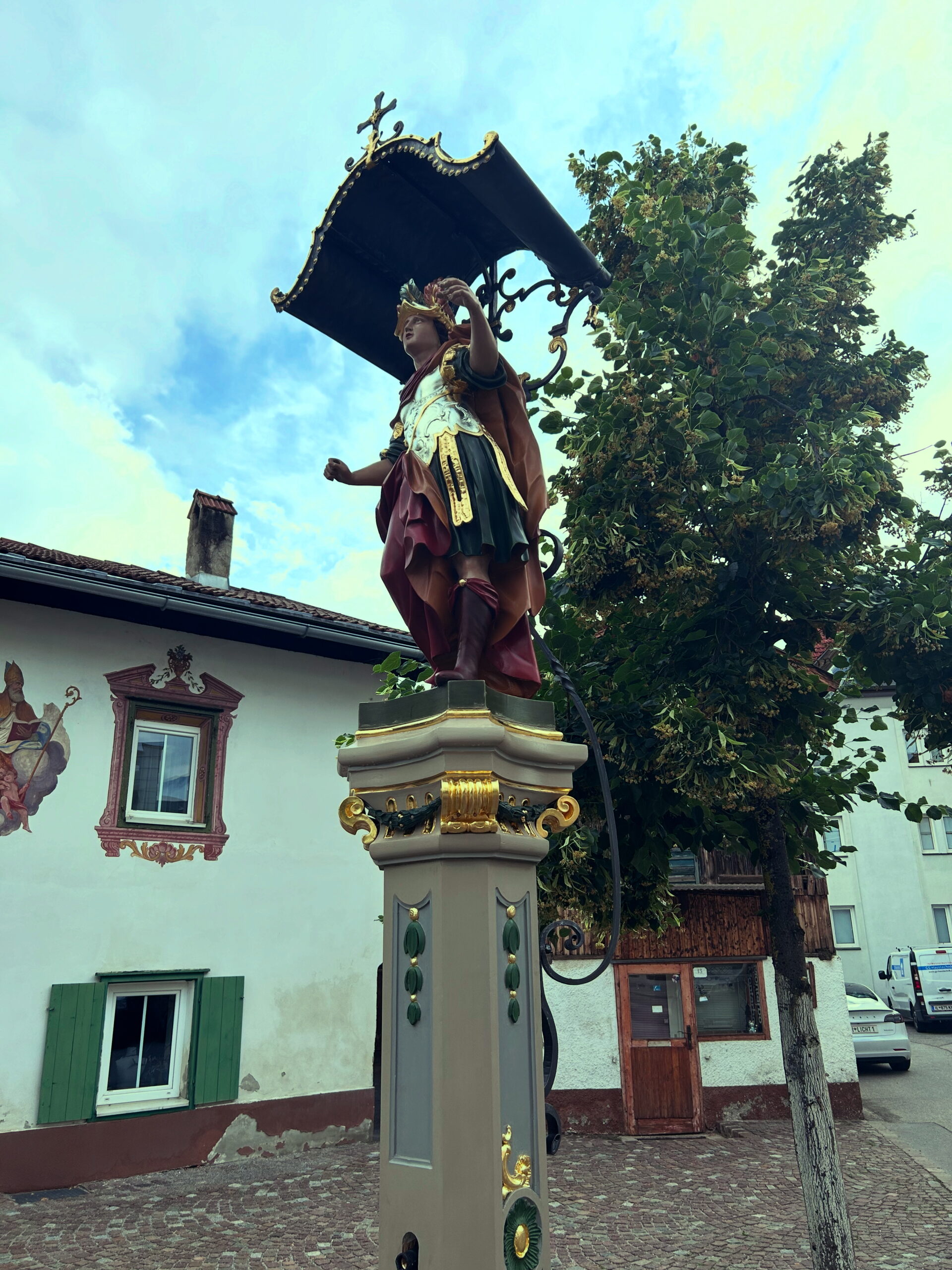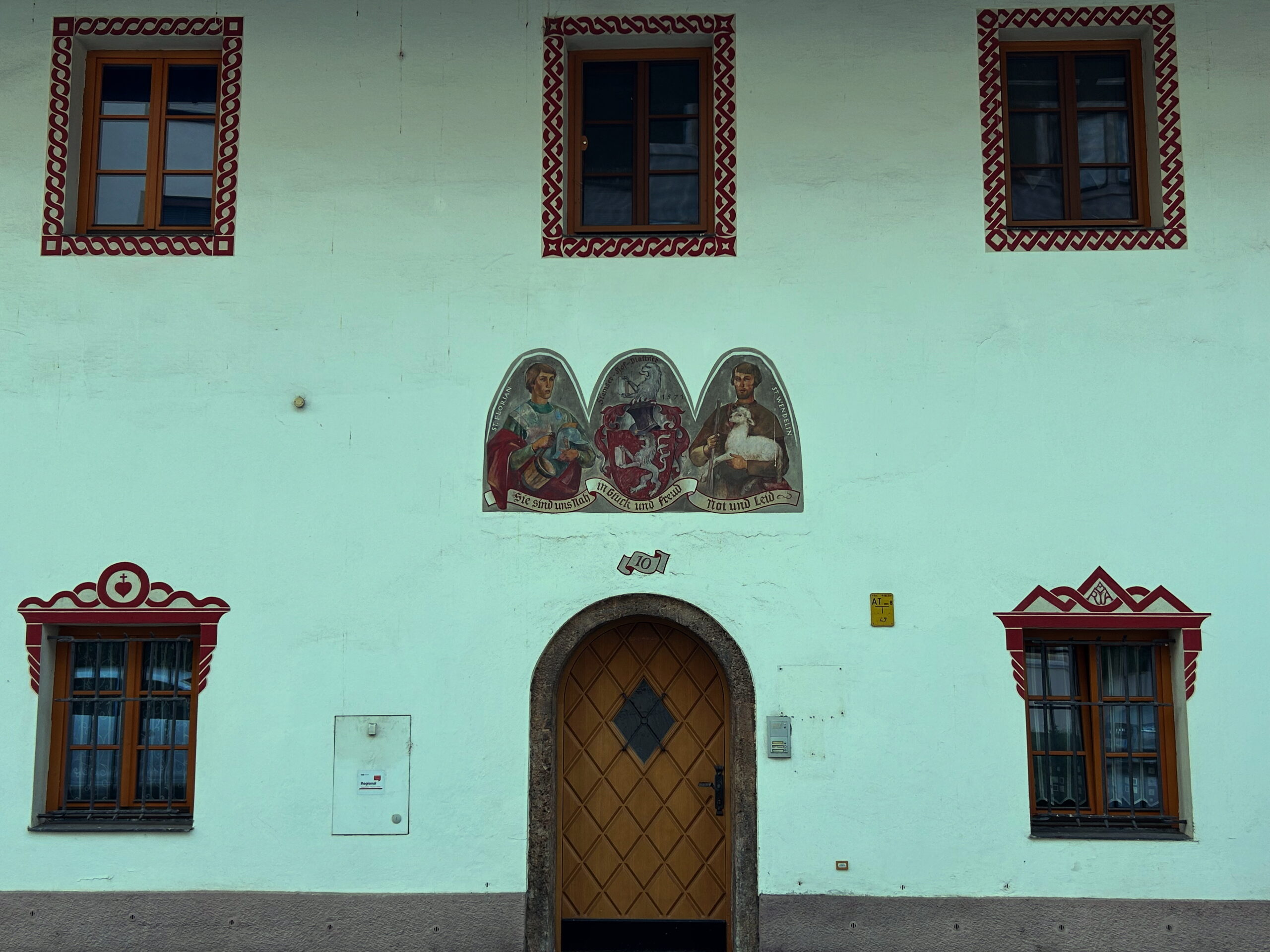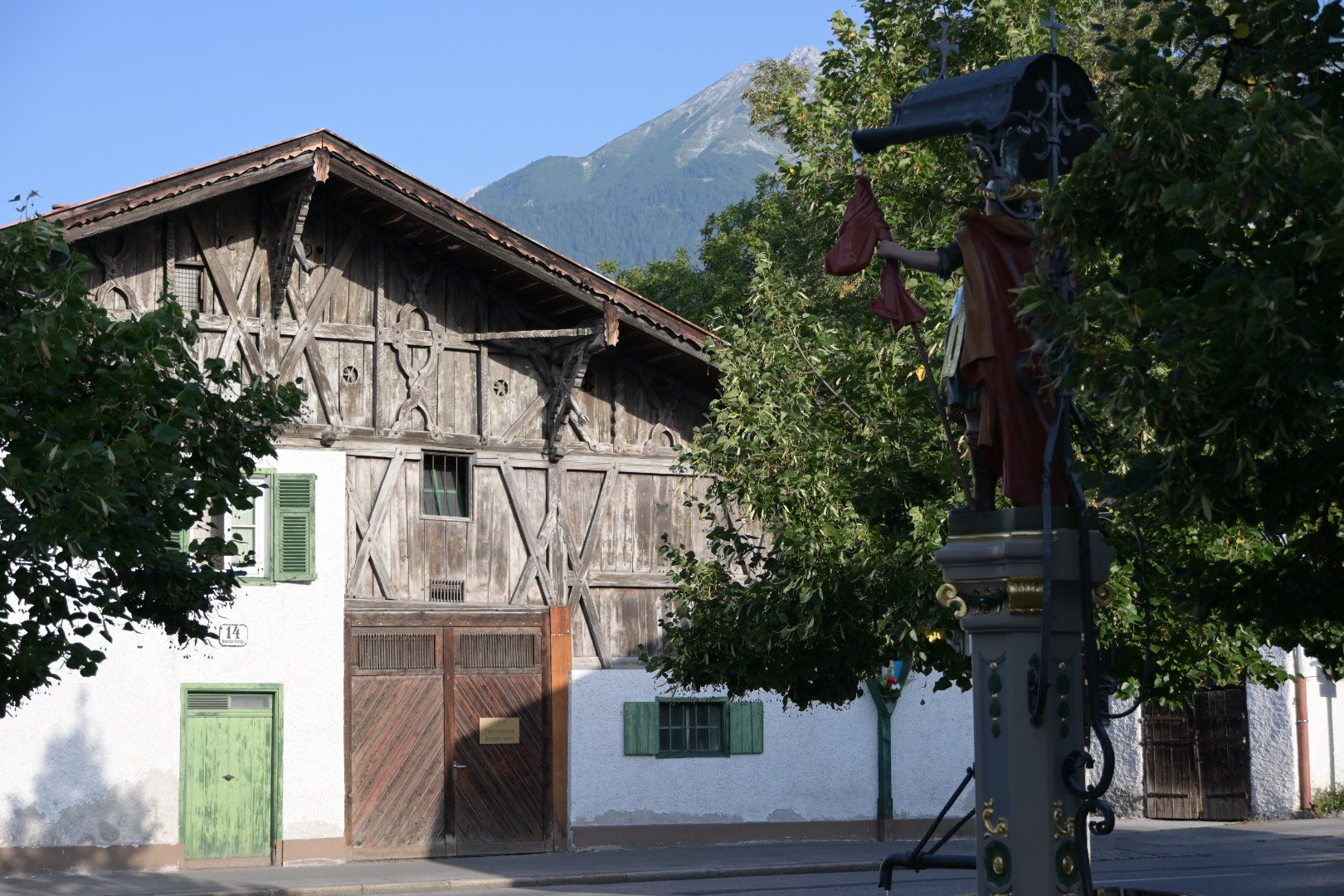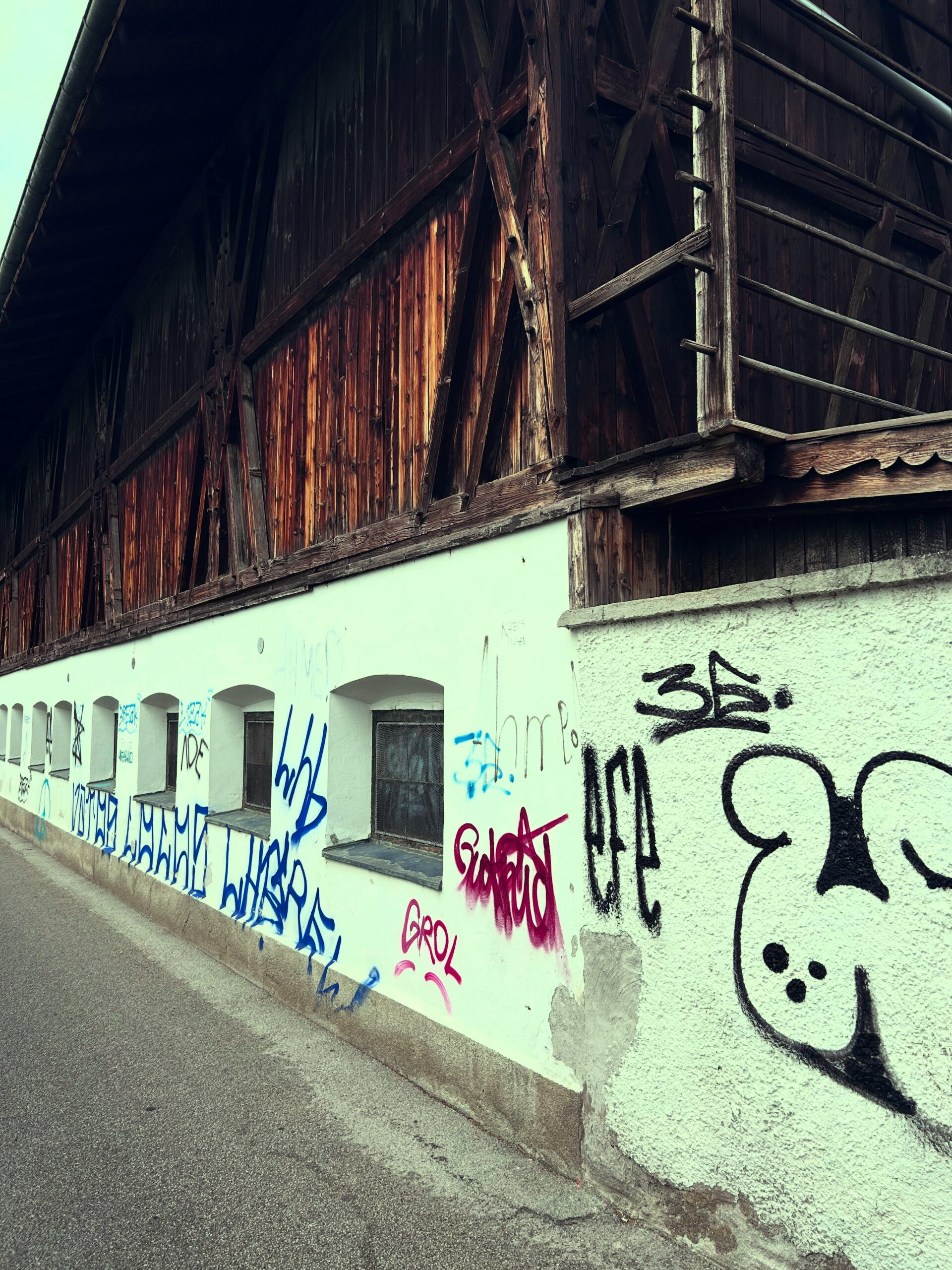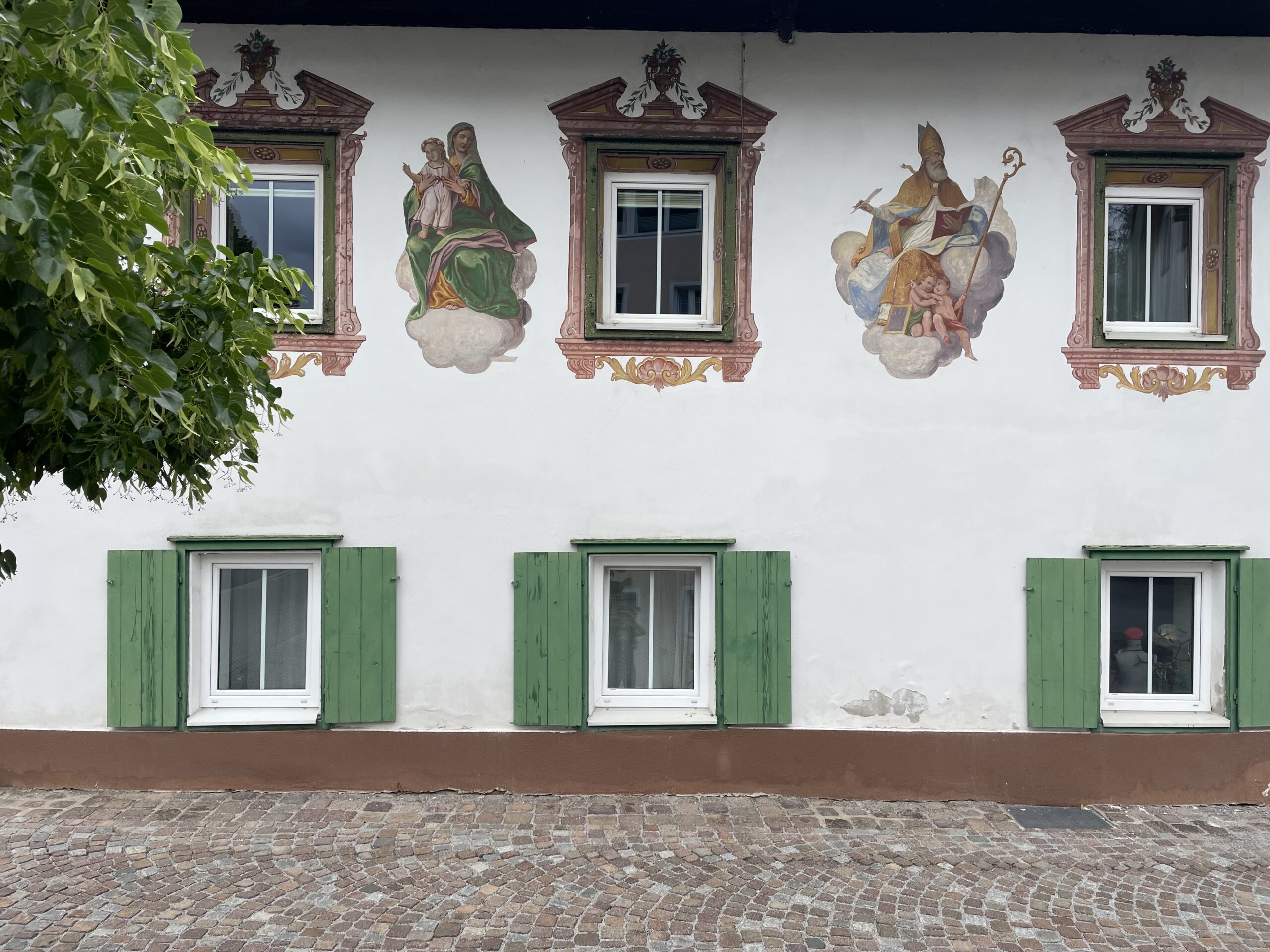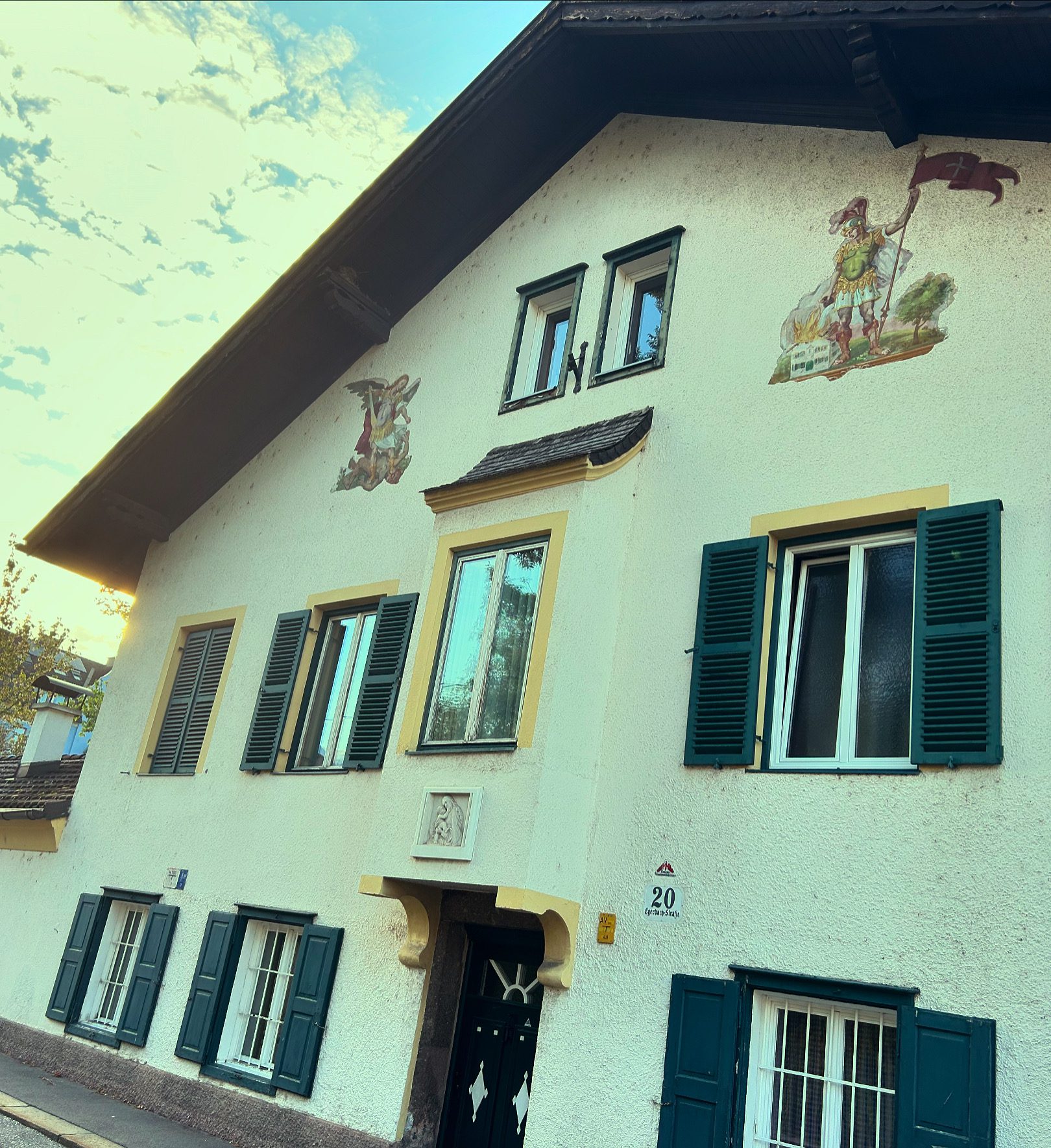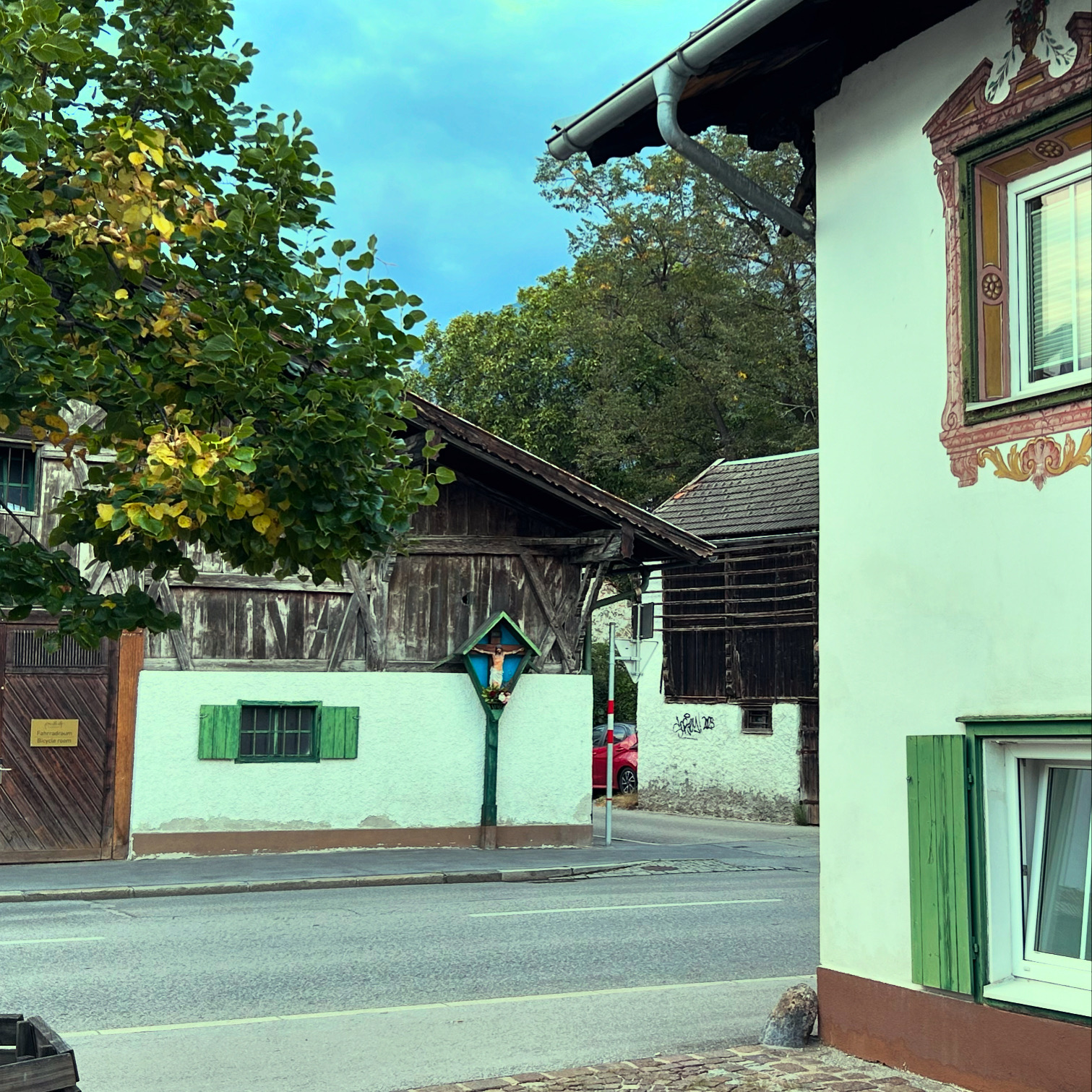Farmhouses in Pradl
Pradlerstrasse / Egerdachstrasse
Worth knowing
Until the 19th century, Pradl was a small rural settlement between the River Sill and today's Pradl parish church, consisting of around 20 farmhouses. The origins of the village can be traced back to a manor of the Counts of Andechs. The oldest farm can be traced back to the 13th century. In the early modern period, the farmers became prosperous thanks to social development, which is still reflected in the buildings today. The farmers of Pradl focussed on livestock farming early on. The townspeople and nobility as well as the craftsmen and skilled labourers consumed more expensive meat than the average Tyrolean in past centuries. The supply of food to the population was subject to police controls. Not only poor quality, but also usury was penalised. A police act from 1748, in which a butcher from Pradl was penalised for usury, shows just how strict the early food controls were. exceeding of meat weight has been fined.
The small square with the baroque statue of St Florian, built in 1865 and extended in 1913 Florianibrunnen is still a popular meeting place in Pradl today. The patrons of this village centre were the Hörtnagl family. The Hörtnagls are the most successful example of a career from cattle farmer to entrepreneur. The Hörtnaglhof at Egerdachstraße 20 with a statue of Our Lady of Mercy and paintings of St Florian and St Michael the Archangel dates back to 1580. Andrä Hörtnagl founded a butcher's shop in 1862. The company grew under his son Hans Hörtnagl (1864 - 1944). The politically active and influential family also played a key role in major infrastructure projects such as the construction of the slaughterhouse in Saggen. They were able to skilfully expand their property. In the 1930s, Hans Hörtnagl enabled the city to build the Hörtnaglsiedlung on one of their plots of land in the west of the city. To this day, the traditional Hörtnagl company is an integral part of the Tyrolean gourmet landscape.
In the Egerdachstraße and Pradlerstraße around the Florianibrunnen there are other beautiful manor houses. At Egerdachstraße 10 there is the Stamserhof The Plattner family has another farmhouse worth seeing. St Florian and St Wendelin flank the family's coat of arms and the pious motto: "They are close to us, in happiness and joy, hardship and sorrow." The Lodronische Hof (Egerdachstraße 11) has also existed since the 16th century. Here the Pradler Bauerntheater its location, which with pieces such as Der letzte Rottenburger oder die Tochter des Geächteten Innsbrucker and the staging of the Tyrolean fight for freedom in 1809 attracted many city dwellers to rural Pradl. The two-storey baroque farmhouse (house number 20) right next to the Florianibrunnen bears a wall painting of the Virgin Mary by Rafael Thaler (1870 - 1947) from around 1920.
Most of the Pradler farms are no longer in operation as agricultural estates. Between Pembaurstraße and the farm known as Fackngassl There are still a few horses in the well-known part of Gabelsbergerstraße. The manor houses, richly decorated in rural baroque style, are still worth seeing as relics of Pradl's not too distant past as a village.
Tyrol in the hands of farmers
Identification with the farming community is still very high in Tyrol. Although less than 2% of the population live from agriculture today, farmers manage to have above-average representation in society thanks to their lively associations, skilful self-presentation and political structures. This was not always the case. For centuries, the vast majority of people worked in agriculture, but farmers had hardly any political clout. The landlords not only owned the land, but also had power over the people. Builders itself. There was no question of the subjects acting independently as active participants in the economic cycle. Rent was regularly collected in kind. The local petty nobility administered the farming communities within their territory and paid their dues to the sovereign or the bishop. Only gradually did the peasantry develop into the proud status it still enjoys today.
The hierarchical structure of the estate was similar to that of medieval and early modern society as a whole. There were three types of relationship between peasants and landlords. Throughout the Middle Ages, the Leibgeding common. Peasants worked on the manorial estates as serfs. This serfdom could go so far that marriage, property, mobility and other matters of personal life could not be freely decided. This form was already a thing of the past in the vast majority of Tyrol in the early modern period.
The second form, the Free pencilThe tenancy was a lease of a farm for a certain period of time, usually one year. It was usually extended, as both landlords and farmers benefited from a constant business relationship, similar to employers and employees today. However, the subjects did not have a legal right to remain on their estate, nor were there any documents that contractually regulated the legal transaction. Oral contracts were subject to customary law and tradition. The landlord could move his builders back and forth within his estates or hire them out completely. pin...to throw them out the door. If the farm was passed on from a farmer to his son within the family with the consent of the landlord, a Honour due, a payment of up to 10% of the farm value.
The third and most modern form was the Inheritance loan. Even with this form of lease, the land remained the property of the landlord, a Staking was no longer so easily possible. Heirs paid less interest than Pen people. In autumn, either on St Gall's Day (16 October) or on St Martin's Day (11 November), the farmers had to pay their rent in hereditary loans, which shifted more and more from payments in kind to the sounding of coins. Farmers were able to expand their farms through acquisitions or skilful marriage policies. Farms were inherited within the family. Old farmers who sold their property with the warm handThe heirs, who were handed over during their lifetime, retained the right to live at the court and were paid an agreed Ausgedinge supplied.
Peasant inheritance law varied from region to region. In the North Tyrolean Oberland and in South Tyrol, the Real division in other words, the farm was divided up among all the heirs. This automatically led to a fragmentation of the estates and lower profitability. In the Innsbruck region and the lowlands, on the other hand, the Division of inheritance common practice. With few exceptions, the eldest child inherited the entire farm in order to maintain the structure. The siblings of the sole heir usually had no choice but to leave. They had to earn a living as servants, craftsmen, farmhands and maidservants. When Söllhäuslerpeople with a small house and perhaps a garden but no land to speak of, they belonged to the Pofelwhich was made up of innkeepers, travelling folk, prostitutes, servants, maidservants and beggars. In the event of illness or destitution, they had claims against the heir and could be accommodated on the farm for a certain period of time. Depending on the value of the farm, the heir's siblings were also entitled to interest, although this was usually little or nothing. Even back then, farmers were skilful at minimising the book value of their estates.
In the 15th century, the political rules of the game began to change. The lesser nobility had always been a thorn in the side of the sovereign princes as an intermediate level between them and their subjects with their own jurisdiction. Step by step, a modern state began to emerge at the end of the Middle Ages. Monarchs and the high aristocracy wanted to exercise direct rule over their subjects. Although the estate-based society and birthright were not affected by this development, the role of the lesser nobility changed. They went from being lords with power of disposal over their subjects to administrators of their estates and organisers of national defence in the name of the respective prince.
In order to minimise the influence of the lesser nobility, Frederick IV stipulated in his Land Ordinance of 1404 that the legal recognition of the Inheritance loan fixed. With the exception of the territories of the prince-bishops of Trento and Brixen in Tyrol, this form of granting agricultural estates subsequently prevailed over the Free pencil through. Legal disputes between peasants and landlords had to be negotiated before the sovereign. With this daring political act, Frederick bought the immediate affection and loyalty of his subjects in order to gain direct access to military manpower and tax payments. The peasants had the advantage of no longer being at the mercy of their landlords.
With the Inheritance loan farmers became entrepreneurs of sorts, participating in early capitalism as market players. Although they were still subject to the whims of nature and the political climate, such as wars or customs regulations, they now had the opportunity to rise from the subsistence level of previous centuries. After paying the tithe and providing for the household, they sold their goods on the market. Motivated and hard-working farmers were able to build up a certain level of prosperity.
As a result of the economic changes that took place in Innsbruck from the 15th century due to its elevation to a royal seat and in the towns of Hall and Schwaz due to the mining industry, the farmers in the neighbouring villages also benefited from the upswing. The people who worked as officials at court or in the New Industry The people who were employed in mining formed a middle class with greater purchasing power. The demand for meat increased. This in turn led to a change in agriculture. Farmers discovered livestock farming as a more lucrative source of income than arable farming.
Thanks to inflation following the discovery of the New World and the financial upheavals of the 16th century, the amount of rent that farmers had to pay as a monetary value also decreased. Smaller farmers, who received their farms as freeholds and had to pay their dues in kind, suffered from the devaluation of money, while large farms benefited from it.
These developments led to new social relationships on the farms themselves and to greater differences within the peasantry. Peasants presided over their servants in all matters, similar to the Pater Familias of the extended family in ancient Rome. Life on the estates had little to do with the wholesome family life that is often propagated today as a traditional Tyrolean lifestyle. Rather, they were clan-like extended family groups that were under the strict regime of the farmer in everyday life: He determined the working day, food, lodging, meagre leisure time and personal relationships. Clear hierarchies developed in the villages. Hereditary farmers had higher status than Pen farmers. Large farmers had more prestige than small farmers. They often presided over their villages. Particularly successful and loyal farmers were awarded their own family coat of arms by the prince and were honoured as Peasant nobility. At a time when honour and status within society were worth at least as much as hard cash under the pillow, the title of free peasant was more than a mere symbol. These structures persisted in the countryside well into the 19th century, and in more remote regions of the country into the 20th century. At the outbreak of the First World War, more than 50% were still working in agriculture in Tyrol. The beautiful farmhouses in Hötting, Wilten Pradl and Amras, on whose façades the family coats of arms and the reference to their status as Hereditary farm are testimony to the rise of the peasantry in the early modern period.
Theatres, country stages, cinemas & Kuno
The Tyrolean State Theatre opposite the Hofburg with its neoclassical façade is still the city's most striking monument to bourgeois, urban evening entertainment. Since its inception, however, this theatre of high culture has largely eked out a dreary existence in terms of audience numbers. From baroque plays about the Passion of Christ in the 16th century to daring productions that were often met with little applause from the audience almost 500 years later, the goings-on at the Landestheater were always the hobbyhorse of a small elite. The majority of Innsbruck's inhabitants passed the time with profane amusements.
Showmen and travelling folk have always been welcome guests in cities. Just like today, there was strict censorship of public performances in the past. What today are age restrictions on cinema films, in the past were restrictions on performances that were not pleasing to God and even complete bans on theatre and drama under particularly pious sovereigns. However, with increasing bourgeoisie and more enlightened moral concepts, the rules gradually became more relaxed.
The Pradler BauerntheaterThe first venue was an open-air stage in the Höttinger Au and, in addition to farmers, craftsmen and students were also part of the ensemble, but this should not detract from the honour of its name and origins. While the state theatre often played to half-empty seats, the amateur actors enjoyed great popularity with their comedies. Employees and labourers made the pilgrimage from the city to the venues in the surrounding villages at the weekend or enjoyed the evening entertainment in pubs. The so-called knight plays with kidnapped princesses, heroic saviours and clumsy villains were particularly popular. Unlike the serious plays in bourgeois theatres, the actors in the peasant theatres interacted with the audience. Interjections from the audience were not stopped, but spontaneously incorporated into the play. It could even happen that the audience, who were not always sober, intervened in the action with their hands.
With increasing success, the company gradually began to professionalise. In 1870, the Pradler Bauerntheater in a hay barn converted into a stage at the Lodronischen Hof in the Egerdachstraße. In the time before the triumph of television, Innsbruck had a whole series of theatres and pubs that entertained their audiences with plays and music. In 1892, the Löwenhaus theatre opened on Rennweg, where the Tyrolean regional studio of the ORF is located today. The wooden building burnt down in the late 1950s, just in time for the rise of state broadcasting. In 1898, the Pradler were guest performers at the Ronacher in Vienna. A few years later, the young and ambitious Ferdinand Exl (1875 - 1942) broke new ground with part of the troupe. For a long time, the saying went: „If you want to go to a farmer's theatre, you won't get your money's worth in the theatre, and if you're not just looking for entertainment in the theatre, but literary stimulation, you won't go to a farmer's theatre." Exl recognised the trend of the time. Employees and workers could not afford the horrendous ticket prices of the state theatre and did not want to see Wagner operas or plays like The Sorrows of Young Werther However, a certain quality of content and presentation was expected. With the so-called literary folk plays by renowned local authors such as Ludwig Anzengruber, Franz Kranewitter and Karl Schönherr, Exl combined entertainment and quality. Anzengruber summarised the development:
„Anzengruber's Tyroleans not only sing Schnaderhüpfel, platteln d'Schuh, swear like Croats and scuffle, but they are also people with a subtle psyche who have their own thoughts about various problems and develop their own philosophy.“
The first play staged by Exl The priest of Kirchfeld from the pen of Anzengruber was published in 1902 in the Österreichischen Hof on the stage in Wilten. The troupe consisted mainly of members of the Exl and Auer families. In 1903, the company known as Exl stage well-known theatre company Adambräu in Adamgasse, from 1904 to 1915 played popular hits such as Kranewitter's pieces Michael Gaismair und Andre Hofer im Lion house at the Hofgarten. In addition to the plays, tourists were also treated to typical local entertainment such as zither recitals and "genuine, smart Tyrolean Schuhplattler dance" was offered. The first international tour to Switzerland and Germany began in 1904. The press and audiences were enthusiastic about the German-national flavoured pieces performed by pithy Tyrolean lads and pretty girls. In 1910, Exl bid farewell to its existence as an amateur troupe and, in addition to a few veterans, mainly hired "Townspeople" and professional actors.
However, the First World War and the associated travel restrictions put the brakes on further tours. The troupe became part of the Innsbruck City Theatrewhose audience was also receptive to lighter fare during the hard times. Ernst Nepo, an artist who was characterised by his Germanism and early membership of the NSDAP, was responsible for the stage sets.
After the toughest post-war years, things started to look up again. From 1924, the Exl stage In addition to the Stadttheater, Exl also regularly performed at the Raimundtheater and the Wiener Komödienhaus in winter. The political developments of the 1930s greatly favoured the German folk spirit that was inherent in many of the plays that Exl brought to the stage. Like Nepo, he also joined the NSDAP, which was banned in Austria, in 1933. A year later, he planned his first tour of the German Reich. The Austrian government, led by Dollfuß, banned the performances in a last stand against the National Socialists. It was not until 1935 that the Exl Bühne in Berlin was able to stage Karl Schönherr's play Faith and home perform. The Berliner Morgenpost of 4 April 1935 described the piece as "...Art that flows from the depths of the German nation and flows back into the hearts of moved and grateful listeners". After 1938, Exl also received media support in Vienna and became known as "...the antithesis of the completely Judaised, artistically Bolshevised... theatre business" was celebrated. The founder of Exl Bühne died in 1942. His wife and son took over the business and became part of the Tyrolean State Theatre after the war. In the 1950s, the theatre group once again toured successfully in West and East Germany before disbanding in 1956.
Times had changed, Cinema killed the Theatre Star. Moving pictures in cinemas were competing with the stage. The enterprising Ferdinand Exl had also foreseen this development early on. In 1912, his ensemble appeared in the French film Speckbacher which heroically portrayed the Tyrolean uprising. The first cinema film flickered across the screen in the Stadtsaal in Innsbruck in 1896, just one year after the world's first ever cinema, in front of a fascinated audience. The cinema quickly became part of everyday life for many people. In addition to silent films, audiences were shown propaganda messages, especially during the war. Cinemas sprang up like mushrooms in the following decades. In 1909, a cinema opened at Maria-Theresien-Straße 10, which was later known as the Central moved to Maria-Theresien-Straße 37. After the war, it became the Nonstop cinemawhere you paid your ticket for a run of news, cartoons, adverts and feature films that was constantly repeated. In 1928, the Red Cross opened the Kammer Lichtspiele in Wilhelm-Greilstraße to finance the new clubhouse. The Triumph was located at Maria-Theresien-Straße 17 and remained a central cinema until the 1990s. Dreiheiligen was home to the Forum cinema, which is now the Z6 youth centre. In 1933, the Höttinger Gasse opened the Lion cinemawhich was built in 1959 as the Metropol in the listed Malfatti house opposite the Inn bridge, where it still exists today. In the final phase of the Second World War, the Laurin light shows Innsbruck's largest cinema in the middle of the South Tyrolean settlement in Gumppstraße opened its doors. Robert and Walter Kinigadner, two South Tyrolean optants who had already gained experience in the cinema industry in Brixen, took over the running of the 800-seat cinema. Harmless local films alternated with Nazi propaganda. The Exl stage used the Laurin, which functioned as a cinema until the 1970s, for theatre performances. Today, a supermarket is located behind the pillars at the formerly grand entrance. On the wall above the cash desk area, you can still see the murals depicting the legend of the legendary dwarf king Laurin and the German hero Dietrich von Bern in the typical look of National Socialist art. In 1958, on the premises of the former Innsbruck Catholic Workers' Association, the Leocinemawhich is still in operation today and is an integral part of the Innsbruck film scene.
For a short time, cinema and theatre coexisted before cinema took the upper hand. At its peak in 1958, Innsbruck's cinemas sold an incredible 3.5 million tickets. Then the television in the living room gradually took over information and evening entertainment. In addition to entertainment, the cinema also took on a role in sexual education. In the 1970s, naked breasts flickered across the screens for the first time. Films such as Schulmädchenreport and Josefine Mutzenbacher also brought the sexual revolution a little closer to the Tyroleans.
When the Austrian Broadcasting When the new radio went on air in 1955, hardly anyone had a terminal to receive the meagre programme. That was soon to change. In Innsbruck, the Metropol at the Inn bridge and the new bridge built at the turn of the millennium Cineplexx There are still two big players in Wilten. Cinematograph und Leocinema are aimed at an alternative audience away from the blockbusters. The open-air cinema takes place in the Zeughaus in August. The Pradl theatre troupe has survived to this day, albeit under a new name. In 1958, they found a new home in the Bierstindl cultural pub. The amateur theatre troupe Innsbruck Knights' Games enjoys great popularity and full ranks to this day. The play The rogue Kuno von Drachenfels revives the tradition of past centuries every year, including a repeat of the beheading scene and humorous interaction with the audience. A street in the Höttinger Au neighbourhood commemorates Ferdinand Exl. The Alpenheim country house in Saggen, better known today as Villa Exl, where the family lived, is a Tyrolean Heimatstil building with paintings by Raphael Thaler that is well worth seeing.
Baroque: art movement and art of living
Anyone travelling in Austria will be familiar with the domes and onion domes of churches in villages and towns. This form of church tower originated during the Counter-Reformation and is a typical feature of the Baroque architectural style. They are also predominant in Innsbruck's cityscape. Innsbruck's most famous places of worship, such as the cathedral, St John's Church and the Jesuit Church, are in the Baroque style. Places of worship were meant to be magnificent and splendid, a symbol of the victory of true faith. Religiousness was reflected in art and culture: grand drama, pathos, suffering, splendour and glory combined to create the Baroque style, which had a lasting impact on the entire Catholic-oriented sphere of influence of the Habsburgs and their allies between Spain and Hungary.
The cityscape of Innsbruck changed enormously. The Gumpps and Johann Georg Fischer as master builders as well as Franz Altmutter's paintings have had a lasting impact on Innsbruck to this day. The Old Country House in the historic city centre, the New Country House in Maria-Theresien-Straße, the countless palazzi, paintings, figures - the Baroque was the style-defining element of the House of Habsburg in the 17th and 18th centuries and became an integral part of everyday life. The bourgeoisie did not want to be inferior to the nobles and princes and had their private houses built in the Baroque style. Pictures of saints, depictions of the Mother of God and the heart of Jesus adorned farmhouses.
Baroque was not just an architectural style, it was an attitude to life that began after the end of the Thirty Years' War. The Turkish threat from the east, which culminated in the two sieges of Vienna, determined the foreign policy of the empire, while the Reformation dominated domestic politics. Baroque culture was a central element of Catholicism and its political representation in public, the counter-model to Calvin's and Luther's brittle and austere approach to life. Holidays with a Christian background were introduced to brighten up people's everyday lives. Architecture, music and painting were rich, opulent and lavish. In theatres such as the Comedihaus dramas with a religious background were performed in Innsbruck. Stations of the cross with chapels and depictions of the crucified Jesus dotted the landscape. Popular piety in the form of pilgrimages and the veneration of the Virgin Mary and saints found its way into everyday church life. Multiple crises characterised people's everyday lives. In addition to war and famine, the plague broke out particularly frequently in the 17th century. The Baroque piety was also used to educate the subjects. Even though the sale of indulgences was no longer a common practice in the Catholic Church after the 16th century, there was still a lively concept of heaven and hell. Through a virtuous life, i.e. a life in accordance with Catholic values and good behaviour as a subject towards the divine order, one could come a big step closer to paradise. The so-called Christian edification literature was popular among the population after the school reformation of the 18th century and showed how life should be lived. The suffering of the crucified Christ for humanity was seen as a symbol of the hardship of the subjects on earth within the feudal system. People used votive images to ask for help in difficult times or to thank the Mother of God for dangers and illnesses they had overcome.
The historian Ernst Hanisch described the Baroque and the influence it had on the Austrian way of life as follows:
„Österreich entstand in seiner modernen Form als Kreuzzugsimperialismus gegen die Türken und im Inneren gegen die Reformatoren. Das brachte Bürokratie und Militär, im Äußeren aber Multiethnien. Staat und Kirche probierten den intimen Lebensbereich der Bürger zu kontrollieren. Jeder musste sich durch den Beichtstuhl reformieren, die Sexualität wurde eingeschränkt, die normengerechte Sexualität wurden erzwungen. Menschen wurden systematisch zum Heucheln angeleitet.“
The rituals and submissive behaviour towards the authorities left their mark on everyday culture, which still distinguishes Catholic countries such as Austria and Italy from Protestant regions such as Germany, England or Scandinavia. The Austrians' passion for academic titles has its origins in the Baroque hierarchies. The expression Baroque prince describes a particularly patriarchal and patronising politician who knows how to charm his audience with grand gestures. While political objectivity is valued in Germany, the style of Austrian politicians is theatrical, in keeping with the Austrian bon mot of "Schaumamal".
